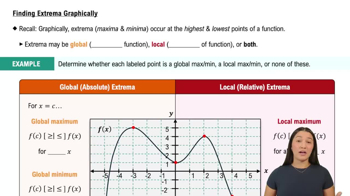Table of contents
- 0. Functions7h 52m
- Introduction to Functions16m
- Piecewise Functions10m
- Properties of Functions9m
- Common Functions1h 8m
- Transformations5m
- Combining Functions27m
- Exponent rules32m
- Exponential Functions28m
- Logarithmic Functions24m
- Properties of Logarithms34m
- Exponential & Logarithmic Equations35m
- Introduction to Trigonometric Functions38m
- Graphs of Trigonometric Functions44m
- Trigonometric Identities47m
- Inverse Trigonometric Functions48m
- 1. Limits and Continuity2h 2m
- 2. Intro to Derivatives1h 33m
- 3. Techniques of Differentiation3h 18m
- 4. Applications of Derivatives2h 38m
- 5. Graphical Applications of Derivatives6h 2m
- 6. Derivatives of Inverse, Exponential, & Logarithmic Functions2h 37m
- 7. Antiderivatives & Indefinite Integrals1h 26m
- 8. Definite Integrals4h 44m
- 9. Graphical Applications of Integrals2h 27m
- 10. Physics Applications of Integrals 2h 22m
5. Graphical Applications of Derivatives
Intro to Extrema
Problem 81b
Textbook Question
{Use of Tech} Optimal boxes Imagine a lidless box with height h and a square base whose sides have length x. The box must have a volume of 125 ft³.
b. Based on your graph in part (a), estimate the value of x that produces the box with a minimum surface area.
 Verified step by step guidance
Verified step by step guidance1
Step 1: Start by expressing the volume of the box in terms of x and h. Since the box has a square base, the volume V is given by V = x^2 * h. We know the volume is 125 ft³, so we have the equation x^2 * h = 125.
Step 2: Solve the equation from Step 1 for h in terms of x. This gives h = 125 / x^2.
Step 3: Write the formula for the surface area S of the box. Since the box is lidless, the surface area is the area of the base plus the area of the four sides. This is given by S = x^2 + 4xh.
Step 4: Substitute the expression for h from Step 2 into the surface area formula from Step 3. This gives S = x^2 + 4x(125 / x^2).
Step 5: Simplify the expression for S obtained in Step 4. This results in S = x^2 + 500/x. To find the value of x that minimizes the surface area, you would take the derivative of S with respect to x, set it to zero, and solve for x.
 Verified video answer for a similar problem:
Verified video answer for a similar problem:This video solution was recommended by our tutors as helpful for the problem above
Video duration:
8mPlay a video:
Was this helpful?
Key Concepts
Here are the essential concepts you must grasp in order to answer the question correctly.
Volume of a Box
The volume of a box is calculated by multiplying its height by the area of its base. For a box with a square base of side length x and height h, the volume V is given by the formula V = x²h. In this problem, the volume is fixed at 125 ft³, which establishes a relationship between x and h that must be maintained while optimizing for surface area.
Recommended video:

Example 5: Packaging Design
Surface Area of a Box
The surface area of a box is the total area of all its faces. For a lidless box with a square base, the surface area S can be expressed as S = x² + 4xh, where x² is the area of the base and 4xh accounts for the four vertical sides. Minimizing the surface area while maintaining a constant volume is a key aspect of this optimization problem.
Recommended video:

Example 1: Minimizing Surface Area
Optimization in Calculus
Optimization involves finding the maximum or minimum values of a function. In this context, we use calculus techniques such as taking derivatives to find critical points where the surface area is minimized, subject to the constraint of a fixed volume. This often involves setting up a function for surface area in terms of a single variable and applying the first and second derivative tests to identify optimal dimensions.
Recommended video:

Intro to Applied Optimization: Maximizing Area

 5:58m
5:58mWatch next
Master Finding Extrema Graphically with a bite sized video explanation from Callie
Start learning





